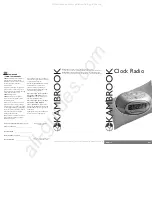
A-80 UHF
SERVICE MANUAL
- 10 -
The RF amplifier output signal is passed through a low-pass filter network and a transmit /receive
switching circuit before it is passed to the antenna terminal. The transmit /receive switching circuit is
comprised of D200, D301 and D302. D301 and D302 turned on (conductive) in transmit mode and off
(isolated) in receive mode.
5) APC
The automatic power control (APC) circuit stabilizes the transmitter output power at a
predetermined level by sensing the drain current of the final amplifier Field effect Transistor (FET). The
voltage comparator, IC201B (2/2), compares the voltage obtained from the above drain current with a
reference voltage which is set using the microprocessor. An APC voltage proportional to the difference
between the sensed voltage and the reference voltage appears at the output of IC201A (1/2). This output
voltage controls the gate of the FET power amplifier, which keeps the transmitter output power constant,
The transmitter output power can be varied by the microprocessor which in turn changes the reference
voltage and hence, the output power.
6
)
Terminal protection circuit
When the thermistor (TH2) reaches about 80°C, the protection circuit turns on Q215 to protect
transmitting final amplifier (Q201) from the over heating.
5.Power supply
A 5V reference power supply [5V] for the control circuit is derived from an internal battery. This
reference is used to provide a 5V supply in transmit mode [TXC], a 5V supply in receive mode [RXC],
and a 5V supply common in both modes [PLC] based on the control signal sent from the
microprocessor.
6.Control system
The IC2 CPU operates at 18.0178 MHz. This oscillator has a circuit that shifts the frequency
according to the EEPROM data.











































